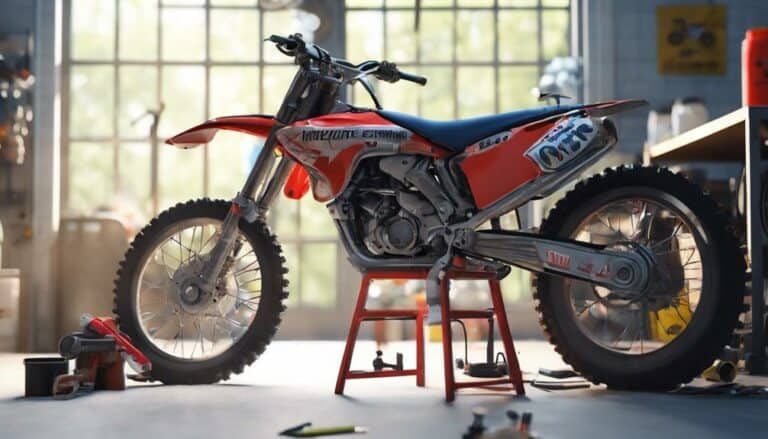Keeping your motocross bike in top shape requires a careful balance of time and effort.
But how often should you tackle these maintenance tasks to guarantee your bike's peak performance?
Let's explore the key factors that influence the frequency of maintenance routines for your motocross machine.
Key Takeaways
- Clean or replace air filter every 3-4 hours to prevent power loss and overheating
- Inspect brake pads at 1mm for safety and performance
- Change engine oil every 5-8 hours to maintain engine health
- Check chain tension every 3-5 hours to prevent premature wear
Frequency of Air Filter Maintenance
To guarantee peak engine performance and longevity, it's essential to clean or replace your motocross bike's air filter before each ride or every 3-4 hours of use. Proper maintenance of air filters is essential, especially when riding in dusty terrains. Dust particles can quickly clog up the filter, leading to decreased airflow and a potential loss of power. A dirty air filter can also result in reduced horsepower and, in extreme cases, engine overheating.
Regularly inspecting and servicing your air filter according to manufacturer recommendations is key to preventing these issues. By staying proactive with air filter maintenance, you can make sure that your bike operates at its best and avoids costly engine damage. Remember, the air filter is a crucial component that directly impacts your engine's performance, so keeping it clean and in good condition is vital for an optimal riding experience.
Timing for Brake Pad Inspection
Inspect your motocross bike's brake pads when the material thickness reaches around 1mm to guarantee peak performance and rider safety. The erosion rate of brake pads can vary depending on riding conditions, so regular inspections are essential.
Some brake pads come equipped with wear indicators, offering a visual cue for replacement. To accurately measure the thickness, make use of a micrometer. Remember, maintaining proper brake function is essential not only for your safety but also for the best bike performance.
Ignoring brake pad inspection can lead to decreased stopping power and compromised handling, posing a risk to both you and your bike. Stay proactive by adhering to a routine inspection schedule and replace the brake pads promptly when needed.
Engine Oil Change Interval
Maintaining prime engine performance and prolonging the lifespan of your motocross bike requires changing the engine oil every 5-8 hours of riding or every other ride. Adhering to manufacturer recommendations on oil change intervals is vital for best performance and to extend the engine's lifespan. Here are four key reasons why timely oil changes are essential for your motocross bike:
- Prolong Engine Lifespan: Regular oil changes as per the suggested interval help in extending the life of your bike's engine.
- Prevent Costly Repairs: By changing the engine oil at the right time, you can avoid expensive repairs that may arise from poor lubrication.
- Maintain Bike Performance: Proper engine lubrication, achieved through timely oil changes, ensures that your bike continues to perform at its best.
- Ensure Engine Health: Engine oil management is vital for the overall health of your engine, contributing to its efficiency and longevity.
Chain Tensioning Schedule
Regularly checking and adjusting chain tension on your motocross bike is important for best performance and safety. To maintain proper tension, it's recommended to check the chain tension every 3-5 hours of riding or after every ride in extreme conditions. Measure chain slack using the manufacturer-recommended methods to make sure the proper tension is maintained. Keeping the chain at the ideal tension is critical for top suspension movement and overall bike performance.
Failure to adjust chain tension can lead to premature wear on the sprockets and other components of your bike. By maintaining the correct tension, you not only guarantee the longevity of your bike's parts but also secure safe and efficient motocross riding. Adjusting the chain tension at the specified intervals will help you avoid unnecessary damage, keeping your bike in top condition for a smooth and enjoyable riding experience.
Sprocket Replacement Timing
To guarantee top performance and safety of your motocross bike, timely replacement of sprockets is essential when noticeable wear or irregularities appear on the teeth. Proper sprocket maintenance plays a critical role in ensuring smooth power transfer and extending the life of your chain. Here are some key points to take into account for sprocket replacement timing:
- Inspect Teeth Regularly: Check for signs of wear, deformation, or asymmetrical teeth on the sprockets.
- Replace When Necessary: If sprockets develop hooks, pointed tips, or uneven wear patterns, it's time for a replacement.
- Avoid Chain Issues: Worn sprockets can lead to chain skipping and premature chain wear, affecting overall performance.
- Enhance Chain Longevity: Regularly replacing sprockets at the right time not only prevents chain-related problems but also helps extend the life of your chain, saving you time and money in the long run.
Conclusion
To sum up, maintaining your motocross bike is like tuning a finely crafted instrument. Just as a musician must care for their instrument to produce beautiful music, a rider must care for their bike to achieve peak performance.
By following a regular maintenance schedule, you can make certain your bike runs smoothly and efficiently, allowing you to conquer any terrain with ease.
Remember, a well-maintained bike is the key to a successful ride.

